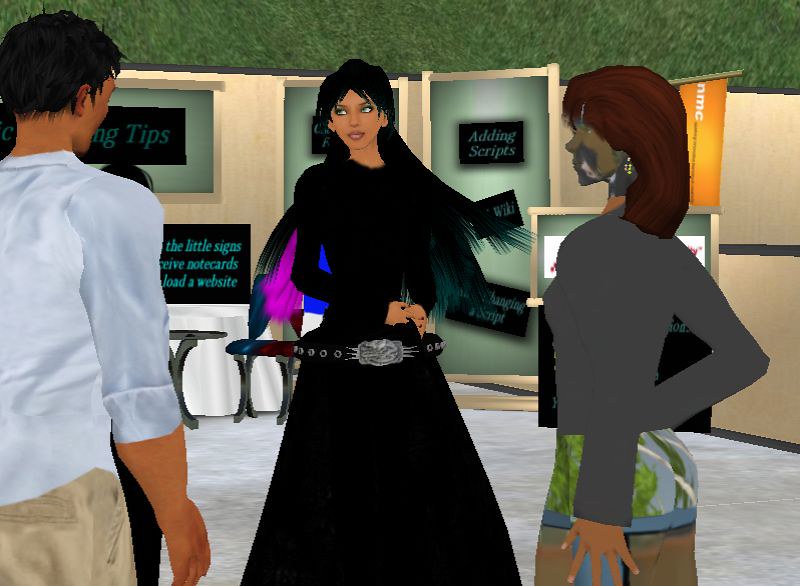I recently felt like this wistful gal during a recent online seminar- isolated, lonely, and wishing to go outside and play.
With nose-diving budgets and more work moving online, it’s time to raise the bar on how we run online events.
Like a horrendously designed PowerPoint, no one sets out with a plan of creating a deadly dull online seminar, but they seem to happen often enough. Frankly, since the first kinds I recall seeing in the late 1990s, even with new software, little seems to change and the form feels as tired as a lecture on fungi:
- Speakers talking non stop over long series of slides; which geometrically and via audio dominate the environment,
- Audience participants are marginalized to passively listening or ignoring the content while they fritter away on a small text chat area. Or they leave themselves logged in while they go outside to wash their car or check the weather.
I am not writing this like I have all the answers or to ridicule the efforts of others, but I have organized more than a few of these, and wish to share just my ideas based on that experience. There are guaranteed more ideas out there or more people that know more than me.
The session I attended was hosted in GoToMeeting (or technically GoToWebinar) which has been around a long time; I’ve only used it before to do a small conference meeting with a vendor showing me a product. And it is very likely the limitations I saw were more an issue of the convener struggling with the meeting options, but the result was not very conducive
So if you want to run a really deadly online seminar, and don;t know how to do that, here are some pointers.
Make it hard to even get inside. Maybe it was vestigal issues with my now upgraded Firefox 3.0, but every link I tried to access the meeting for both a preview and the day off, failed to load the java client, and kept bopping me to a FAQ page where there was a link to “join meeting”, resulting in an endless circle. I got in fine in Safari.
Technically I understand why there is a big handoff for these Java based apps, but in Elluminate I hate ending up littering my desktop with meeting.jnlp files and no matter how many times I tell Elluminate I trust them, I have to click through a dialog box. This is minor, but it puts a speed bump into my experience.
Don’t let your participants know who else is there. This meeting I was in there was a box to list participants, but all it had as a number at the top .Talk about isolation, not being able to see who else was in the shared space was so isolating. Does anyone get what the “social” part of social software is about? People, relationships, proximity.
Make it hard or impossible for the audience to communicate with each other. This seminar was set up with a common set of tools I see also in Connect. Rather than having an open chat area for free flowing conversation, it has a question box- participants can enter questions but no other participants can see them, instead, they are queued to a moderator who is supposed to respond in an orderly fashion. It is audience filtering.
This may seem logical in some sort of flow chart instructional design world of arrows and boxes, but is a killer for the audience experience, and layers even more isolation on the experienceI never use these tools in my seminars. I leave an open chat because my audience are adults who can engage in conversations, answer questions, etc, without some hall monitor filtering their voices.
Don’t greet the audience or make them feel welcome. I got into this session 15 minutes before it started, and there was no chat message, no welcome screen (the presenters were flipping slides), and on one greeted or welcomed the audience. In fact, all I could hear on the audio was someone keyboarding, probably IM-ing or tweeting. Another layer of isolation for this deadly seminar cake.
This is so easily managed, do I really have to spell it out? For our online events, I try to be the first one in the room. As people arrive, I greet them in text or voice, if I know them I can see something in reference to what I know, if not I can extend a welcome message. Also (and I stole this idea from EDUCAUSE) because often people cannot tell if their audio works, I play a track of audio as background music- I play from a 30 minute collection of music from open content sources.
What you want to avoid is the enemy of radio- dead air.Once there is a group of people, I may ask them to respond in chat to a simple question like, “introduce yourself and let us know where you are from?” or “How about letting us know what you see from where you are sitting now.” or “I just finished lunch and had a turkey sandwich- what is in your lunch plans?”I learned so much about this from Johnathan Finkelstein’s Learning in Real Time (book and web site), especially a portion that compared running an online event to hosting a dinner party. In his work I have seen at LearningTimes, Jonathan is not only a virtuoso in hosting, he is an expert at using the technology well to have people be actively engaged.
Get the book now if you do real time events. And want them to be of the non deadly variety.
Ignore your audience, make ’em wait til you fill the hour with your voice, do not involve them at all. Most online sessions are so focused on moving through a slide deck, they marginalize people to some 3 minute Q&A after the allotted time has ended. If you want an audience, interact with them. break up the presentation. Create an activity. Let someone from the audience lead the show. Use a game, a tool, a survey, a whiteboard.
I am sure there are more ways to be deadly, but I hope you see my point.
Just like classroom lectures, there are a minority of people that can be enaging, interesting, in an online monologue mode, but most of us are not. An online seminar is a different venue than an in person audience, and we ought to be taking advantage of what the environments provide, not shoe horning old presentation modes into new boxes.
Frankly the slide flipping presentations with marginalized audiences just about bore me from the start.
As much as people can scoff or say “harrumph” at Second Life, over at NMC we have been running our online conferences in a virtual world space for almost 2 years, and can see categorically (and have feedback collected) that the amount of social engagement feels an order of magnitude higher because, even with the cheesy graphics, there is a real social presence that happens there, In a web based seminar, as soon as a session ends (or before) people peel off and log off– at our virtual world events, people linger, share, converse between the sessions. They engage in informal session just be virtue of being social.
The amount of social interaction in a narrow marigin chat window on the side of slides is extremely limited.
We can do better.
Unless… you really want to be deadly, then you have at least my 5 tips.
Bonus Update! Five ways not enough? A new one is to sign up people who log into your seminar to an email list! People love getting unsolicited sales materials!
Featured Image:






Alan, I have too much to say on this to simply leave a comment, so I’ll gin up a post, but I think it is worthwhile to observe that there are a variety of skills involved here:
* technology stewardship of the tools (and in SELECTION of tools. I avoid MS Livemeeting, GoTOMeeting and WebEx whenever I can for very specific reasons I’ll write about. ) This includes pre event instructions, graceful ways of helping people learn to use the tool, presenter prep and during event tech help.
* presenter skills – design for interest, clarity, interactivity
* facilitation skills – (and this doesn’t have to be the presenter alone! In fact, I think all online events should have at least 2 on the team) – socialization, meaning making, supporting presenter, etc.
This is not brain surgery. We just have to a) not accept crappy tools and practices!!!!
Thanks Nancy, I eagerly await your post. I was remiss in not also mentioning your longtime work in advancing online facilitation (slap me with a chocolate bar, okay?).
Ironically, these sorts of tools have been around for like 10 years, but the overall use of them is pretty much the same as it ever was.
Yeah, the tech has been around for 10 years, but our poor presenting and group facilitation skills have been around for eons! 😉 Crap offline becomes double crap online!
I’ve had similar problems with the lack of two-way communication in Go2Meeting and try to avoid it as well. Asking questions only to the presenter does not constitute interaction.
When I present online I always make sure that I have enough stuff to talk about to fill ALL the time though. I do this because each group is different and sometimes you get one where no one asks any questions or makes comments. That can make for a lot of dead air if you’re not prepared. However, I usually cascade my presentation so that I can stop and/or branch in several places if the audience is interested and wants to converse.
I think you need at least 3 people for an effective real-time conference, in these 3 key roles: presentation; back-channel/interaction; and tech support.
You’re right, we can do better and we’ve had these technologies for a long time.
Yeah, I am thinking the product name is GoToMeetingAlone.
Another point I forgot was when I am running a session that you expect to have a Q&A, we ask presenters before the session to provide 2-3 questions they would like to answer, just so our moderators can ask if the audience does not jump in right away. Usually once one person asks, others step up.
You are right on about many hands helping out.
Alan,
Thanks for your post. I was in the conference you describe – or I tried to be. It was, in fact, deadly. I could not stay. (And I’ve been in a LOT of web-conferences this summer). A bit of irony that the topic of the conference was user participation in web conferences…and folks in that conference could not really participate (no eating of their own dog food going on!). I have NOT hosted conferences, but hope to for my faculty this fall…to show them how it could/should be done. I have learned loads this summer by participating in the good and this bad. I think I am particularly sensitive to this topic right now because of your point…’with nose-diving budgets and more work moving online, it’s time to raise the bar on how we run online events.’ Right on – we can and should be doing a better job.
I am an online facilitator and designer and I use WebEx. Very successfuly I might add. The problem I see within my orgainization is, as someone else mentioned, people delivering webinars or small group learning events who don’t have a clue as to what they are doing. They haven’t mastered the technology, haven’t been a participant and have had no training. But then I attend a lot of webinars that are hosted/facilitated by people who are supposedly an expert and they are awful. Killer powerpoints, bad delivery or, a platform such as GoToMeeting that does not allow for interaction. (Yes, I went to that webinar too) I left waaaayyy before it was over. There are skills required for this venue just as there are for any face to face presentation or training. Why don’t people get that???????
It seems that webinar hosts are still using webinar 1.0 style of frontal delivery. Thanks to Alan for mentioning Jonathan Finkelstein’s book ‘Learning in real-time’, the bible of live online delivery as far as we are concerned.
We train educators on how to use webconferencing aright and have introduced two ‘products’ to try to avoid the above deadly recipe.
a) A learning conversation ‘On demand’
What is unusual about this is, that participants of the webinar request to meet a speaker or a trainer, not the other way round. The other way round would be that the training organisation provides the webinar dictating not only who speaks but also the content. ‘On demand’ means that the participants request their guest speaker and invite their peers to listen to the expert. They are also asked to provide the questions to the guest speaker and run the moderation. I know that sounds very unusual but it works really well. http://virtual-round-table.ning.com
b) Speedy presentations
Presenters who wish to present their content with slides may do so, within a time limit of 3min 20sec with 10 slides auto-advancing every 20sec. We call these presentations PRESTO10x20 which stands for PRESent your TOpic with 10 slides auto-advancing every 20sec. Several of these Prestos may be recorded before the session or run in the session. The rest of the time is for questions and answers. Again, this might sound unusual but you will be suprised how much can be said in little more than 3min.
Imagine webinars were learning conversations and content was to be presented speedily or on demand, would this work to put live back into live online webinar?
Hi Alan,
Thanks for extending the timeframe fro writing comments on your posts. 🙂 Vacationing on a small island was too much fun to read blog posts (though yours are always worthwhile reading, laughing and pondering about).
When I finally got to reading your post, I wondered if we had not been in a webpresentation (don’t want to call it webinar etc. anymore as the interaction was not like in a seminar or workshop) together because I had the very same experience. It is really too bad to see such examples especially when there are many best practice examples around. However, I have the feeling that the trainers who ran the workshops did not know much about this kind of online delivery (and did not care much).
I hate hosting online; it terrifies the crap out of me. Because of that terror, I spend a lot of time asking the audience questions and asking for feedback. If someone chats something, I try to read it out (and attribute it correctly). I email the chat to everyone after and post relevant docs to Google docs and give out the link that doesn’t require them to have Gmail for access. Thanks for the tip on playing music: I usually sing a selection of Shirley Bassey tunes to test everyone’s sound, but your idea is way better… (found link to this from http://twitter.com/ALALibrary)
Deep immersion and social engagement rock! I was thrilled when 80+ educators joined me in my universe simulation to experience how we feel about our research on the Mars Expedition during the NMC Symposium for the Future.
I love virtual world conferences and connecting with educators, CogDog. Thank you for sharing the joy I felt while presenting at the NMC Conference. Those were magical moments that inspired me with a love for the connections of the mind!
We just finished the Virtual Worlds Best Practices in Education 2023 and examined Uncommon Realities. No matter where we go, connecting and sharing are what matters.
Keep on inspiring us! *cheers*
— Lyr Lobo
Indeed and I miss so much the potential and sense of possibility in those times and spaces. And I think I just missed your session by 30 minutes! I saw a tweet about VWBPE 2023, checked the stream, and was unsurprised to hear you in the recording.
Sending a virtual worlds high five from CDB Barkley.